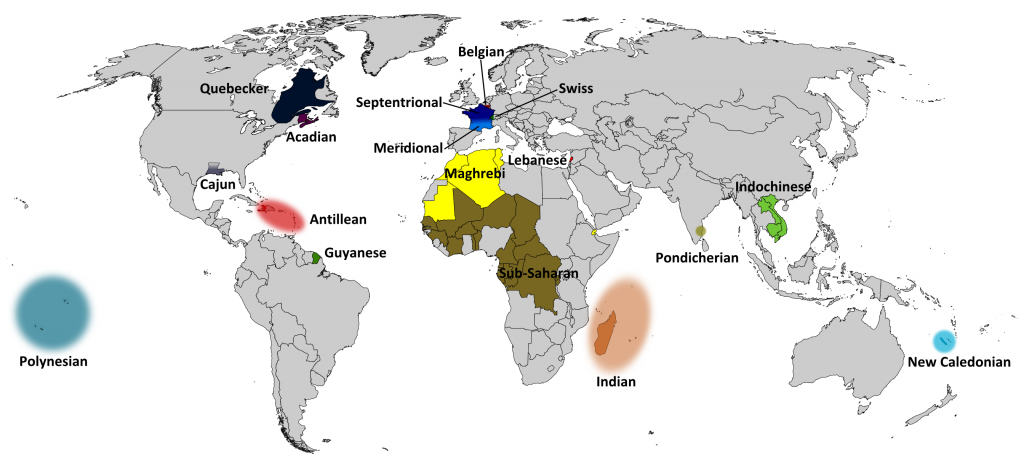The French language has come a long way. What was relevant a few hundred years ago was replaced by modern phrases and terms. In this post, we’ll be taking a look at the evolution of French as a language!
Ça roule?
Comme d’hab!
N’importe quoi!
C’est n’importe quoi!
Ça te dit?/Ça vous dit?
Allez savoir pourquoi!/Va savoir pourquoi!
If you don’t understand those phrases, here’s a clue. Those colloquial expressions are so popular these days. Anyway, these French expressions translate to: “How’s life? Good?” The answer, Comme d’hab means “as usual.” It is a shortened version of the typical and informal reply – comme d’habitude.
Youngsters always utter the next one, which means “whatever!” Following it is an expression when you are exasperated and the nicest thing you can say is, “it’s a lot of nonsense.”
Ça te dit?/Ça vous dit? translates to either “(Are) You up for it?” or “sounds good?” The last one can mean one of these English expressions: “your guess is as good as mine,” ”God knows why” or ”for whatever reason.”
It is fascinating to hear the French speak because the language itself is lovely.
Brief history of the Evolution of French Language Dialects
French is one of the Romance languages that came from Latin and its history is quite interesting. In today’s setting, 53 countries and 76.8 million people speak French or la langue française as their first language.
When you think of the French language, you think of the Gauls that inhabited a Western European region in the past, which included Belgium and the France that we know today. French came from the ancient Gaulish language, although there are no traces left today.
Roman Influence
The Gaulish language is a Celtic language, which was spoken before the Romans came and conquered the area in the 2nd and 1st centuries before Christ. That put an end to the Gaulish language and the reason why French became a Romance language – it’s because they were forced to speak in the way the Romans speak.
Latin became the dominant language in the region and was a requirement if people wanted to rise up the social ranks. The Gaulish language was eliminated, leaving only about 150 words that were included in the French vocabulary. Today, around 70 of those words became the origin of some of the French words today, such as battu, which became ”battre” meaning to beat or batter and artuas that evolved into ”ardoise,” a color that is close to slate or purplish gray.
With the expansion of the Roman Empire, pure Latin became adulterated by other dialects spoken by the people in the lower ranks of society, leading to the creation of Vulgar Latin.
As early as the 9th century, it was already clear that the French spoken during that time was different from Latin. But with the distinct Latin influences that were inherent in its roots, it is easier for speakers of languages derived from Latin to learn French today.
German Influence
The German invasions in the 4th century AD had a big effect on the language. The language of the Franks, Visigoths and the Burgundians again mixed with Vulgar Latin and the other dialects from various regions. The patterns of usage and the stress patterns of the language of the Franks were enforced on Vulgar Latin, which explains why the language, which evolved into French, is different from Spanish and Italian.
In the 5th century, the Franks became the more dominant group and the Frankish language was used by the aristocracy. Some of the Frankish words that are still retained are trop, fauve, brun, guère, bleu and blanc.
Other Influences
Like other languages, French continues to evolve. It was further influenced by English, Italian and Greek, with English having the most influence in modern-day le français. Different dialects and variations of French exist, with Parisian French becoming the model of the language of the French people.
Its structure has not changed very much after it was standardized.
Variations of the French Language
Le Serment de Strasbourg (Strasbourg Oaths) is the first Old French written record. It was a declaration of alliance created in 842 AD between Louis the German and the Charles II, the Holy Roman Emperor. Some historians claim that it was not written in French but in a language that resembles Latin, especially created to make it look authentic for political reasons. Others believed that the scribe who wrote it was struggling with the spelling of the type of French that was spoken during that time.
Another example, written between 880–882 CE (Common Era) was a short description of St. Eulalia’s life. The Old French that was used has features from Walloon and Picard. The Vie de St. Léger and the Passion du Christ, both written in the 10th century, showed Old French mixed with southern and northern dialects.
Only certain areas in Île-de-France spoke Old French, such as Paris and the provinces that surround France. Only around 1% of the population was able to speak it. Old French was very complex and difficult to learn. It contained 16 diphthongs and 33 vowels. The pronunciation is very difficult too. Example of literary work written in Old French is “The Song of Roland.”
The language called the Francien dialect that was used at the time was more of a north-central dialect and showed more features from the northern dialects. It became the language of the literary world.
A Continual Evolution of French
The language continued its evolution. In the 16th century, the language was simplified and many of the diphthongs were eliminated. The structure of the sentence was more uniform but due to illiteracy of the majority of the population, only around 2% was able to write and read Middle French at that time.
In 1539, the Ordinance of Villers-Cotterêts was issued by King Francois I. It decreed that French would be the country’s official language instead of Latin. However the local language was still used by those people who do not belong to the elite circles.
Modern French on the other hand are divided into different eras. During the Grand Siècle in the 17th century, France was very prosperous under King Louis XIV and Cardinal Richelieu. The cardinal showed their absolute power through standardization and centralization. He created the Académie française in order to police and promote their own language.
The grammarians of the Académie set about to ensure the pureness of the language. Hence, they removed many words borrowed from other languages and those that were only used in other provinces. The written and spoken forms of French were created into a practical language, including keeping the ”s” of plural words silent.
The French aristocrats used French exclusively and in 1714, the Treaty of Rastatt established French as the international diplomatic language.
English Rises to Power
After the signing of the Treaty of Paris in 1763, English became a tremendous power. The revolutionary ideas of some of the great English philosophers and political thinkers influenced their French counterparts and new words were added to the French lexicon.
The improvements in travel and transportation enabled people to travel freely. It meant that French became open to more influences and the language added more loan words, especially from Spanish, Latin, Greek, Italian and Germany.
The Catholic Church and the French monarchy were not keen on teaching French to the public and insisted on Latin as the medium of instruction.
But that changed when Bastille was attacked on July 14, 1789 and the majority of the population wanted a republic. They believed that united the people through language is the key.
In 1794 (Reign of Terror), a decree appointed French teachers in all areas, ensuring French was the main medium of instruction. The Jules Ferry laws of the 1800s required French being used in schools. This resulted in higher literacy among the students.
Modern Dialects
French is the national language in France and several other countries that came under French rule in various points in time.
Still, geographical variations of French exist, as follows:
- Northern areas: Northern Norman, Picard
- Eastern regions: Franc-Comtois, Bourguignon, Lorrain
- Southwestern areas: Angoumois, Saintongeais, Poitevin
- Western areas: Manceau, Angevin, Gallo, Norman
- Central regions: Champenois, Bourbonnais, Orléanais, Francien
More than 50 countries around the world speak French either as a first or second language. Some of these countries include Corsica, Canada, Belgium, Switzerland, Monaco, Italy and the United States. They speak French in several countries and regions in Africa, such as Central African Republic, Cameroon, Burundi, Burkina Faso, Benin, Chad, Côte d’Ivoire, Tunisia, Togo and Senegal. Rwanda, Niger, Morocco, Mauritania, Mali, Madagascar, Guinea, Gabon, Equatorial Guinea, Djibouti, Kinshasa and Brazzaville (both in Congo) also speak French. In Asia, one of the languages used in Cambodia, Laos and Vietnam is French.
Characteristics and Features of the French Language
They standardized French between the 17th and 18th centuries. It widely replaced some of the regional dialects in France, especially those spoken in central and northern France. Its phonology differed from the other Romance languages and its grammar was simplified. Plural of nouns had ”-s” or ”-es” added. But we only use them in the written form. Why? Because they aren’t pronounced in speech. There is distinction in the feminine and masculine gender. But they are shown in the adjective or the article that accompanies the noun. Singular and plural verb conjugations are for three persons. And while they are indicated in the spelling, the pronunciation is the same.
Total users of the French language around the world reach 284,952,860 according to Ethnologue 21. It is the world’s second most studied language, with about 120 million students worldwide. Fluency in the French language will depend on many factors, including the amount of time you dedicate to it.
You do not have to be fluent in French when you need document translation. You can rely of the translators of Day Translations to provide you with professional human translation into and from French with a very high level of accuracy. All our translators are native speakers. This means you always get the best translation of your document. Our French translators are located around the world so the service is immediate. Just send us message via email at contact@daytranslations.com or call us at 1-800-969-6853 to request a quote.
Image Copyright:
By Jonatan argento (Own work) [CC BY-SA 3.0], via Wikimedia Commons













Sorry, the comment form is closed at this time.